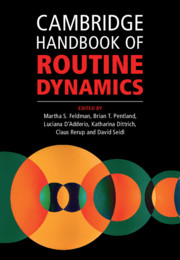Book contents
- Cambridge Handbook of Routine Dynamics
- Cambridge Handbook of Routine Dynamics
- Copyright page
- Contents
- Figures
- Tables
- Contributors
- Preface
- Chapter 1 What Is Routine Dynamics?
- Part I Theoretical Resources for Routine Dynamics Research
- Part II Methodological Issues in Routine Dynamics Research
- Part III Themes in Routine Dynamics Research
- Part IV Related Communities of Thought
- Chapter 33 Carnegie School Experiential Learning and Routine Dynamics
- Chapter 34 Dynamic Capabilities and Routine Dynamics
- Chapter 35 Strategy as Practice and Routine Dynamics
- Chapter 36 Path Dependence and Routine Dynamics
- Chapter 37 Business Process Management and Routine Dynamics
- Author Index
- Subject Index
- References
Chapter 36 - Path Dependence and Routine Dynamics
from Part IV - Related Communities of Thought
Published online by Cambridge University Press: 11 December 2021
- Cambridge Handbook of Routine Dynamics
- Cambridge Handbook of Routine Dynamics
- Copyright page
- Contents
- Figures
- Tables
- Contributors
- Preface
- Chapter 1 What Is Routine Dynamics?
- Part I Theoretical Resources for Routine Dynamics Research
- Part II Methodological Issues in Routine Dynamics Research
- Part III Themes in Routine Dynamics Research
- Part IV Related Communities of Thought
- Chapter 33 Carnegie School Experiential Learning and Routine Dynamics
- Chapter 34 Dynamic Capabilities and Routine Dynamics
- Chapter 35 Strategy as Practice and Routine Dynamics
- Chapter 36 Path Dependence and Routine Dynamics
- Chapter 37 Business Process Management and Routine Dynamics
- Author Index
- Subject Index
- References
Summary
Over time, organizational routines are likely to become persistent or even path-dependent. Such a process is obviously influenced by the degree of routinization; by the complexity, inter¬dependency and complementarity of routines; and also by their embeddedness in (inter-)organizational structures and practices. However, the acknowledgement of the tendency of routines to become path-dependent also depends on the theoretical lens used to examine them. Under the conditions mentioned, the classic view attributes a high likelihood of routines to become path-dependent – and thereby become a source of inertia or persistence, if not of the path dependence of a subunit or entire organization. The more recent view of routine dynamics, by contrast, requires a more nuanced reasoning. Against the background of this debate, the chapter discusses what routine dynamics research can learn from studies of organizational path dependence – and vice versa.
Keywords
- Type
- Chapter
- Information
- Cambridge Handbook of Routine Dynamics , pp. 501 - 512Publisher: Cambridge University PressPrint publication year: 2021
References
- 3
- Cited by



